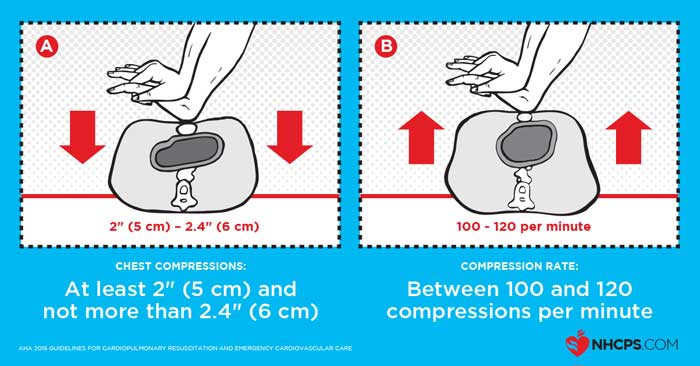Your cart is currently empty!
ILCOR 2015 Guidelines Are Published: CPR Key Points
THE ILCOR HAS RELEASED THE 2015 GUIDELINES for Cardiopulmonary Resuscitation and Emergency Cardiovascular Care, published in the journal Circulation. The guidelines expand on many of the recommendations made in 2010, with a focus on high-quality chest compressions as the intervention most likely to improve resuscitation outcomes.
The ILCOR’s analysis of the research conducted since the 2010 guidelines were published shows that resuscitation outcomes improve when high-quality chest compressions are started immediately. The characteristics which define high-quality CPR remain pushing hard and fast.
Rate: In 2010, the recommended rate was at least 100 compressions per minute. The 2015 update to the CPR guideline now reflects a target compression rate of 100 to 120 per minute. The reason for the addition of an upper rate limit is that rates faster than 120 will likely result in decreased cardiac output due to incomplete cardiac filling during chest recoil.
Depth: A similar refinement of the guideline is compression depth. The 2015 guideline now defines the target depth for compressions as between 5 and 6 centimeters, or between 2 and 2.4 inches. Why this change? Research reviewed by the ILCOR revealed that compressions delivered beyond that depth may result in an increased risk of resuscitation-related injuries to the victim.
Technique: The ILCOR’s guidelines continue to point out that the rescuer technique will play a major role in the quality of compressions delivered. In resuscitations outside the classroom, rescuers are likely to provide compressions that are too slow, too shallow, and interrupted too often. The importance of psychomotor skill training to develop good technique, with frequent knowledge and skill refresher training continues to be emphasized by the ILCOR. During training and refreshers, detailed feedback, especially on rate and depth of compressions, should be provided.
Sequence: The 2010 change from the traditional A-B-C sequence to the C-A-B sequence was confirmed in the 2015 guidelines. The emphasis on early initiation of chest compressions without delay for airway assessment or rescue breathing has resulted in improved outcomes.
Ratio: For trained rescuers, the guidelines continue to recommend traditional CPRs cycles of 30 chest compressions to 2 rescue breaths for single-rescuer CPR in all age groups, and 2 rescuer CPR in adults. The 15:2 ratio of compressions to breaths remains the guideline for 2 rescuer CPR for children and infants.
Community: The focus on high-quality compressions is also reflected in the continued recommendations supporting compression-only CPR, or hands-only CPR delivered by the general public. The ILCOR points out that most responders are likely to have a speakerphone equipped cell phone, and bystanders calling 911 can be instructed by EMS dispatchers to perform hands-only CPR. Additionally, the ILCOR continues to call on communities to increase public access to AEDs.
Resuscitation research continues to show that high quality CPR is increasing survival to hospital discharge. The ILCOR’s updated 2015 guidelines, while not as drastic as the changes published in 2010

10 responses
-
-
Thanks so much for your thoughtful comment! We’re glad you found the update helpful—staying informed on best practices is key to improving response and outcomes in critical situations.
-
-
Great insights on the 2015 ILCOR Guidelines update! It’s fascinating to see how these changes can impact CPR effectiveness and improve survival rates. I appreciate the clear breakdown of the key modifications. Looking forward to implementing these practices!
-
We’re really glad the tips resonated with you. Building confidence through practice can make such a big difference. It’s inspiring to see your dedication — every step you take brings you closer to being ready when it matters most ❤️
-
-
Great summary of the 2015 ILCOR guidelines update! It’s crucial for everyone, especially healthcare providers, to stay informed about these changes. I appreciate the clear breakdown of the key shifts in CPR practices—it’s a reminder that every second counts in emergencies. Thank you for sharing this important information!
-
Thank you so much for your thoughtful feedback! We’re glad to hear that you found the summary of the ILCOR guidelines helpful. Staying up to date with these changes is indeed essential, especially for those in the healthcare field. We truly appreciate your support and commitment to making a difference in emergency care.
-
-
Great insights on the 2015 ILCOR Guidelines update! I appreciate how you’ve highlighted the key changes in CPR techniques. Understanding these updates is crucial for keeping our skills current. Thanks for sharing!
-
Thank you for your kind feedback! We’re glad you found the overview of the 2015 ILCOR Guidelines helpful. Highlighting the key updates in CPR techniques is important to ensure skills stay current and effective, and we’re happy the post supported that goal. We appreciate you taking the time to share your thoughts.
-
-
This update on the 2015 ILCOR Guidelines is incredibly insightful! It’s great to see how CPR techniques evolve to enhance survival rates. I appreciate the emphasis on high-quality chest compressions and the importance of minimizing interruptions. Looking forward to seeing how these changes impact training protocols moving forward!
-
Thank you for your thoughtful feedback! We’re glad you found the update on the 2015 ILCOR Guidelines helpful. Emphasizing high-quality chest compressions and minimizing interruptions is key to improving outcomes, and we’re excited to see how these evidence-based updates continue to shape and strengthen CPR training. We appreciate you taking the time to share your insights.
-







This update on the CPR key changes in the 2015 ILCOR guidelines is incredibly informative! It’s crucial for both healthcare professionals and bystanders to stay updated on these practices to ensure the best outcomes in emergencies. Thanks for breaking down these changes so clearly!